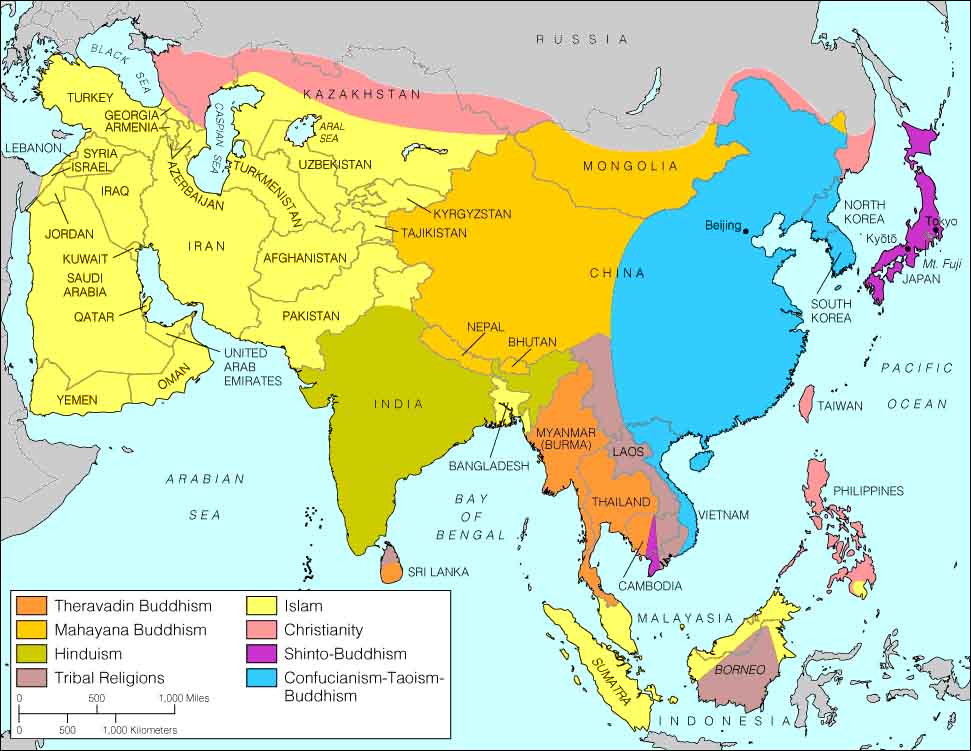Culture and Religion
TEKS Alignment - §113.43. World Geography Studies (One Credit), Beginning 2011-2012.
(1) History. The student understands how geography and processes of spatial exchange (diffusion) influenced events in the past and helped to shape the present. The student is expected to:
(A) analyze the effects of physical and human geographic patterns and processes on the past and describe their impact on the present, including significant physical features and environmental conditions that influenced migration patterns and shaped the distribution of culture groups today;
(B) trace the spatial diffusion of phenomena such as the Columbian Exchange or the diffusion of American popular culture and describe the effects on regions of contact.
(5) Geography. The student understands how political, economic, and social processes shape cultural patterns and characteristics in various places and regions. The student is expected to:
(A) analyze how the character of a place is related to its political, economic, social, and cultural elements;
(16) Culture. The student understands how the components of culture affect the way people live and shape the characteristics of regions. The student is expected to:
(A) describe distinctive cultural patterns and landscapes associated with different places in Texas, the United States, and other regions of the world and how these patterns influenced the processes of innovation and diffusion;
(B) describe elements of culture, including language, religion, beliefs and customs, institutions, and technologies;
(17) Culture. The student understands the distribution, patterns, and characteristics of different cultures. The student is expected to:
(A) describe and compare patterns of culture such as language, religion, land use, education, and customs that make specific regions of the world distinctive;
(C) compare economic, political, or social opportunities in different cultures for women, ethnic and religious minorities, and other underrepresented populations; and
(D) evaluate the experiences and contributions of diverse groups to multicultural societies.
(18) Culture. The student understands the ways in which cultures change and maintain continuity. The student is expected to:
(A) analyze cultural changes in specific regions caused by migration, war, trade, innovations, and diffusion;
(B) assess causes, effects, and perceptions of conflicts between groups of people, including modern genocides and terrorism;
(C) identify examples of cultures that maintain traditional ways, including traditional economies;
| Key Vocabulary | Key Places |
|---|---|
|
Indochina |
Indochina
|
Once you have reviewed the module summary, TEKS alignment goals, and key terms and definitions use the left menu navigation to access all module resources.
Culture and Religion
Southeast Asia is a region defined more by its cultural differences with surrounding regions rather than by any cultural unity within the region. Several countries within this region have more internal cultural diversity than some major world cultural regions. In fact, in many ways, Indonesia could be defined as a culture region all on its own. Its thousands of islands often have their own specific languages and culture groups, which are unrelated even to other parts of the same island – much less those found in other parts of the region. As a result, there are many aspects to teaching the cultures of Southeast Asia.
To begin with, almost every major world religion can be found to a significant degree in this region. Most students (and many people) do not realize that Indonesia has the largest Muslim population in the world. In addition, Hinduism, Christianity, Buddhism, and many of the Chinese religions can be found here often existing side by side with each other more peacefully than they co-exist in other parts of the world. But these familiar religions may seem a bit different here. People in Southeast Asia tend to put their own unique cultural spin on religions and sometimes create their own individual branches. Take for example the Aglipayan Church, a branch of Catholicism unique to the Philippines; and Islam as practiced in Indonesia is much more moderate than found in Southwest Asia.
